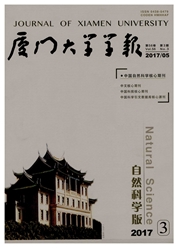

 中文摘要:
中文摘要:
聚乙烯亚胺(PEI)是一类新兴的阳离子多聚物非病毒载体,可缩聚DNA分子形成颗粒并转入真核细胞进行表达.本文选用分子量750ku分枝状PEI与分子量25ku线性PEI转染增强型绿色荧光蛋白(EGFP)报告基因于HeLa细胞,并对这两种PEI的转染效率进行比较.利用MTT法检测比较线性PEI与分枝状PEI的细胞毒性.通过凝胶阻滞实验比较两种PEI结合DNA能力.最后利用肝素介导释放实验比较两者在形成PEI/DNA复合物后释放DNA的能力.研究结果表明:线性PEI转染效率优于分枝状PEI,且随PEI/DNA质量比的增加而升高,而分枝状PEI则相反;两种PEI细胞毒性在一定范围内相近;分枝状PEI结合DNA能力略强于线性PEI;但是分枝状PEI释放DNA的能力远小于线性PEI这可能导致DNA在细胞内无法从PEI/DNA复合体上释放出来,从而影响转录的正常进行,最终导致分枝状PEI转染效率下降.
 英文摘要:
英文摘要:
Polyethylenimine is a widely-used non-viral vector with polycation. It can condense DNA to form PEI/DNA complexes, which can be transfected into mammalian cells for gene expression. In this study, enhanced green fluorescence protein was transfected into HeLa ceUs by linear PEI and branched PEI, then compared the cytotoxic effects by the method of MTT assay. The ability of DNA binding of both linear PEI and branched PEI was identified, and the level of DNA release from PEI/DNA complexes was compared. The results showed that the transfection efficiency of linear PEI was much better than that of branched PEI. Linear PEI transfection efficiency increased with increasing PEI/DNA ratio, while branched PEI was contrary. Both PEI have the same cytotoxic effects in selected range and they have almost the same ability of DNA binding. In addition, DNA is much more difficult to release from branched-PEI/DNA complexes than from linear-PEI/DNA complexes, which may be the reason of the poor transcription leading to decreasing transfection efficiency of branched PEI.
 同期刊论文项目
同期刊论文项目
 同项目期刊论文
同项目期刊论文
 A capping-independent function of MePCE in stabilizing 7SK snRNA and facilitating the assembly of 7S
A capping-independent function of MePCE in stabilizing 7SK snRNA and facilitating the assembly of 7S 期刊信息
期刊信息
